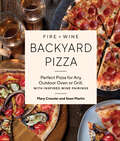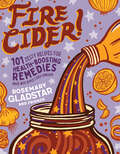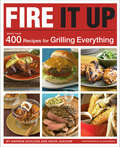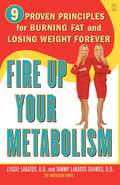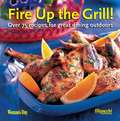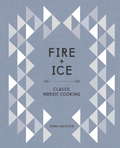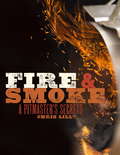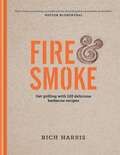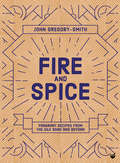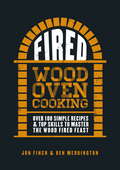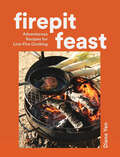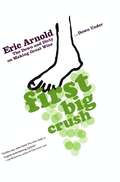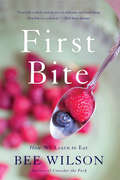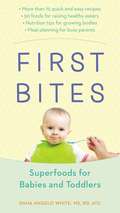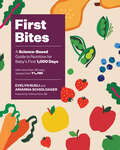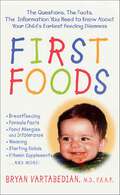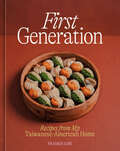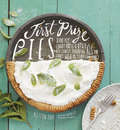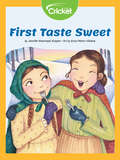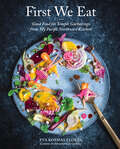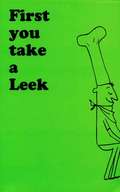- Table View
- List View
Fire + Wine Backyard Pizza: Perfect Pizza for Any Outdoor Oven or Grill, with Inspired Wine Pairings (Fire + Wine)
by Mary Cressler Sean MartinFeed your kids, impress your friends, and enjoy yourself with everyone's favorite food as you master 45 delicious and easy pizzas on your backyard pizza oven or grill—with wine, of course.Everyone loves pizza, but not everyone has the fancy equipment to make a great one at home. Finally, the creators behind Vindulge offer an invaluable resource using devices you probably have at home (a tabletop charcoal grill, even!) and give you the confidence to create endless variations—including breakfast pizza and dessert pizza—so you can customize to everyone's tastes!Authors Sean Martin and Mary Cressler bring their experience as pit master and sommelier to the art of creating the perfect pizza with your favorite outdoor grill or pizza oven, pairing dozens of delicious pizza recipes with the perfect wine every time. You'll find all the classics (hey there, Chicago Deep Dish and Margherita!), but also savory, gluten-free, vegetarian, and even sweet pizzas, making this the only cookbook a pizza lover of any age and palate—even the one who likes pineapple on their pizza—ever needs.Recipes include:Classic Pizzas, such as Deep-Dish Pizza and MargheritaSavory Pizzas, such as Date-Night Steak Dinner PizzaVeggie Pizzas, such as The Forager Pizza and The Pizza SaladFlatbreads, such as Fennel Pollen and Hot Honey FlatbreadBreakfast Pizzas, such as Huevos Rancheros PizzaDessert Pizzas, such as S'Mores Pizza
Fire Cider!: 101 Zesty Recipes for Health-Boosting Remedies Made with Apple Cider Vinegar
by Rosemary GladstarFor more than 30 years, best-selling author and popular herbalist Rosemary Gladstar has been touting the health benefits of fire cider — a spicy blend of apple cider vinegar, onion, ginger, horseradish, garlic, and other immune-boosting herbs. Her original recipe, inspired by traditional cider vinegar remedies, has given rise to dozens of fire cider formulations created by fans of the tonic who use it to address everyday ills, from colds and flu to leg cramps and hangovers. Fire Cider! is a lively collection of 101 recipes contributed by more than 70 herbal enthusiasts, with energizing versions ranging from Black Currant Fire Cider to Triple Goddess Vinegar, Fire Cider Dark Moonshine, and Bloody Mary Fire Cider. Colorful asides, including tribute songs and amusing anecdotes, capture Gladstar&’s passionate desire to pass along the fire cider tradition. This publication conforms to the EPUB Accessibility specification at WCAG 2.0 Level AA.
Fire It Up: More Than 400 Recipes for Grilling Everything
by Andrew Schloss David JoachimThe New York Times bestselling authors of Mastering the Grill present 400 recipes that focus on the joy of great ingredients.Fire It Up shows today’s cooks how to buy, prepare, and grill more than 290 ingredients from beef and pork to chicken, fish, vegetables, fruit, and more. Handy charts explain different cuts, best grilling methods, and perfect doneness. Insider tips throughout the volume solve dozens of dinnertime dilemmas, while gorgeous color photos and useful illustrations bring it all to life. With more than 400 delicious recipes and 160 winning rubs, brines, marinades, and sauces, Fire It Up makes it easy for everyone to become a backyard grill master—no matter what’s on the menu. Jam packed with recipes, tips, and illustrations, Fire It Up is THE grill book for this summer.
Fire Up Your Metabolism
by Lyssie Lakatos Tammy Lakatos Shames"I can't loose weight because I have a terrible metabolism" You may not realize it, but you can take control of your metabolism. Identical twins and registered dietitians, Lyssie Lakatos and Tammy Lakatos Shames embarked on a twin study to determine precisely what does -- and doesn't -- increase the rate at which our bodies burn calories and fat. Their findings? Small changes have big results. The nine weight-loss principles -- and the 200 tips that help you incorporate them into your lifestyle -- in Fire Up Your Metabolism are surprisingly simple: Eat breakfast before you get to work. Learn which sugary snacks trump others (peanut M&Ms boost metabolism, but Twizzlers don't). Drink water, which is essential to burning calories. Always eat dinner, even if it's late. Focus on muscle building, not cardiovascular workouts. With Fire Up Your Metabolism, you won't have to avoid restaurants or follow a diet (though one is included if you like regimentation). The fatigue and distracting hunger that derail most dieters won't affect you because revving your metabolism is all about eating. You will enjoy breads and other carbohydrates. You will boost your metabolism with power proteins, including hamburgers, and avoid other proteins that bog you down. You will indulge in snacks you thought a dieter could never touch. Lyssie and Tammy's clients have experienced not only dramatic weight loss but also the thrill of having more energy than ever before. Now you, too, can rewire your metabolism to lose weight fast and forever.
Fire Up the Grill! Over 75 Recipes for Great Dining Outdoors
by The Editors of Woman's DayOver 75 Woman's Day recipes for great dining outdoors - from a simple backyard barbeque to an elaborate alfresco dinner party.
Fire and Ice
by Darra GoldsteinBringing the best of Scandinavian home-cooking into your kitchen, Fire and Ice: Classic Nordic Cooking offers over 100 delicious recipes that showcase this region's most beloved sweet and savory dishes. Scandinavia is a region of extremes--where effortlessly chic design meets rugged wilderness, and perpetual winter nights are followed by endless days of summer--and Fire and Ice proves that Scandinavian cuisine is no exception. Founding editor of Gastronomica and the West's leading culinary authority on the cuisines of the European North, Darra Goldstein explores the rich cultural history and culinary traditions of Denmark, Finland, Norway, and Sweden. From the bold aroma of smoked arctic char to the delicate flavor of saffron buns, and from the earthy taste of chanterelle soup to the fragrant aroma of raspberry-rose petal jam, this beautifully curated cookbook features over 100 inspiring and achievable recipes that introduce home cooks to the glorious and diverse flavors of Nordic cooking.From the Hardcover edition.
Fire and Smoke
by Chris LillyGrill like a pro with the expert recipes and tips in Fire and Smoke. World champion pitmaster Chris Lilly combines the speed of grilling with the smoky flavors of low-and-slow barbecue for great meals any night of the week, no fancy equipment required. Cook trout in a cast-iron skillet nestled right in smoldering coals for a crispy yet tender and flaky finish. Roast chicken halves in a pan on a hot grill, charring the skin while capturing every bit of delicious juice. Infuse delicious smoke flavors into fruits and vegetables, even cocktails and desserts. Fire and Smoke gives you 100 great reasons to fire up your grill or smoker tonight.
Fire and Smoke: Get Grilling With 120 Delicious Barbecue Recipes
by Rich HarrisFire & Smoke shows how to barbecue mouthwatering recipes with smoky and succulent flavours that will see you through the summer and beyond in style. Organised into chapters on:* From the Sea - delicious fish and seafood dishes* Crowd-pleasers - food to impress friends, such as Beef Short Ribs and Sticky Pork Belly & Rice Noodle Salad* Hand-held - get messy with Chilli Dogs, Smoked Chicken Wings and Lamb Shish Kebabs* Smoking - featuring hot-smoked classics like Pulled Pork and Prawns with Dirty Romesco Sauce to Cold smoked Salmon* Veggies, Sides & Breads - barbecues aren't just about meat so indulge in Chargrilled Leaves with Burnt Lemon Dressing, Cauliflower Steaks and Chipotle Slaw* Sauces, Dips & Pickles - accompaniments to take your dishes to the next level* Cocktails & Coolers - drinks to wash down and complement your grilled dishes* Desserts - indulge in Toasted Marshmallow Ice Cream and what barbecue would be complete without s'Mores?* Restoke the Flames - ideas for the morning after including Buttermilk Pancakes and Brunch Pizzette. This is the ultimate guide to cooking with fire and smoke.
Fire and Spice: Fragrant recipes from the Silk Road and beyond
by John Gregory-SmithA fragrant treasure trove of recipes from across the globeSpices have been bringing fragrance and fire to food for thousands of years, and they are as relevant today as they have always been - versatile, healthy, economical, and, more importantly, utterly delicious. However, many people find spices confusing and equate them to endless shopping lists or old jars gathering dust in their cupboards. This treasure trove of recipes from 'spice master' John Gregory-Smith will demystify the spice cupboard and show readers how to blend these delicious flavours for mouthwatering results.The book opens with a fascinating introduction to spice cookery and a full glossary of the different spices, their flavour notes and how to use them. Drawing inspiration from all over the world, the recipes in this book offer a culinary passport to China, Vietnam, Cambodia, Thailand, Indonesia, Malaysia, India, Sri Lanka, Lebanon, Turkey, Morocco, Mexico and beyond. Try Vietnamese Star Anise & Lemongrass Chicken Claypot, Indian Fish Cakes with Coriander & Coconut Chutney or Manchurian Lamb with Tamarind Slaw and Griddled Chilli Potatoes.The recipes are divided into chapters on street food, curries, salad, grills, stews, vegetables, meat and desserts and drinks, and offer delicious dishes for any time of the week, from quick and easy mid-week meals to sumptuous weekend feasts. Every recipe is accompanied by a stunning photograph of the finished dish and accompanied by wonderfully evocative stories from John's travels. Whatever the occasion, the food contained in these pages is a feast for the senses that will make any meal a celebration.
Fired
by Jon Finch Ben MerringtonThe wood oven revolution is here.Anyone with an outside space, from a city centre balcony to a leafy green country garden, can pick up an outdoor oven and start cooking. The range available is expanding all the time - catering for every budget and skill level - and yet until now there hasn't been a book that offers an all-round guide to cooking on the new kit on the block.Fired fills that gap with aplomb. The book shows you how to cook the finest pizza known to man of course, but it goes much further, offering recipes for meat joints, one pot stews, breads and even desserts. It holds the reader's hand on the journey to outdoor oven expertise, showing just how versatile and exciting outdoor wood oven cookery can be.
Fired: Wood Oven Cooking: Over 100 Simple Recipes & Top Skills To Master The Wood Fired Feast
by Jon Finch Ben MerringtonThe wood oven revolution is here.Anyone with an outside space, from a city centre balcony to a leafy green country garden, can pick up an outdoor oven and start cooking. The range available is expanding all the time - catering for every budget and skill level - and yet until now there hasn't been a book that offers an all-round guide to cooking on the new kit on the block.Fired fills that gap with aplomb. The book shows you how to cook the finest pizza known to man of course, but it goes much further, offering recipes for meat joints, one pot stews, breads and even desserts. It holds the reader's hand on the journey to outdoor oven expertise, showing just how versatile and exciting outdoor wood oven cookery can be.
Firepit Feast: Adventurous Recipes for Live-Fire Cooking
by Diana YenTake outdoor cooking to the next level with this fire pit cooking bible by a live-fire expert. There&’s nothing quite like cooking over an open flame. Fire infuses ingredients with its own unique flavors, elevating everything from a hot dog to fresh fruit to a hearty stew with elements of smoke and char. And fire pit cooking makes it even easier to cook with live fire. In Firepit Feast, Diana Yen shares 75 approachable and unique recipes full of flavor to make the most of a backyard stove or campside fire pit, including: *Salmon with Crushed Olives and Tomatoes *Miso-Butter Gnocchi and Mushrooms *Chicken and Oyster Mushroom Satay *Churrofluffs with Hot Chocolate *Japanese Sweet Potatoes with Chili Butter And much more! Diana Yen shows that fire pit cooking is about much more than s&’mores—though, yes, she includes instructions for a tasty, crowd-pleasing S&’morgasboard, too.
First Big Crush: The Down and Dirty on Making Great Wine
by Eric ArnoldThe story behind the bottle, First Big Crush is Eric Arnold's wild account of his year immersing himself in all things wine... and somehow not winding up in rehab. Never having held a meaningful job for very long (and getting fired from most of them), Eric Arnold heads to New Zealand -- to Allan Scott Wines -- seeking adventure and hoping to learn a little bit about wine. What could be better than working outside in the fresh air and drinking wine all day? Before he knows it, he is dirty, wet, cold, and at the mercy of a tank of wine that just might explode and take him with it. So begin Eric's adventures in the world of wine. He gets sunburned, sore, and drunk -- and then does it all over again the next day. First Big Crush is a story that is as outrageous as it is compelling. Here are tales of first pressings, pruning, and tasting competitions. There are also rowdy nights at the local pub, girls, meat pies, girls, rugby, and tales of hunting wild pig. Along the way, each step of the winemaking process is explained in a way that humans can actually understand. Almost against his will, Eric becomes an expert.
First Bite: How We Learn to Eat
by Bee WilsonWe do not come into the world with an innate sense of taste and nutrition; as omnivores, we have to learn how and what to eat, how sweet is too sweet, and what food will give us the most energy for the coming day. But how does this education happen? What are the origins of taste?In First Bite, the beloved food writer Bee Wilson draws on the latest research from food psychologists, neuroscientists, and nutritionists to reveal that our food habits are shaped by a whole host of factors: family and culture, memory and gender, hunger and love. An exploration of the extraordinary and surprising origins of our tastes and eating habits--from people who can only eat foods of a certain color to an amnesiac who can eat meal after meal without getting full--First Bite also shows us how we can change our palates to lead healthier, happier lives.
First Bites
by Dana Angelo WhiteFIRST BITES is a "cheat sheet" approach to introducing 50 superfoods into baby and toddler diets, with tips and recipes to show parents how to raise healthy eaters for life. FIRST BITES is the quick and easy reference guide that all parents can keep on hand to whip up tasty and nutritious meals for their babies and toddlers in no time. Recipes are designed to help to foster healthy eating habits and create a diet filled with 50 fresh, minimally processed superfoods that are just as delicious as they are healthy. In this book, fruit and veggies take center stage in new and exciting ways, yet parents will also learn to create healthy spins on classic kid favorites like mac and cheese, pizza, chicken fingers and cupcakes. FIRST BITES offers all the tools parents need to turn the naturally healthy foods they have on hand into delectable breakfasts, lunches, dinners and snacks designed to encourage youngsters to become strong and healthy eaters for a lifetime.From the Trade Paperback edition.
First Bites: A Science-based Guide To Nutrition For Baby?s First 1,000 Days
by Evelyn Rusli Arianna SchioldagerHelp your little one become a good, healthy eater. Until age 2, a child’s body develops at superspeed—with 60 percent of calorie intake going straight to brain development—so good nutrition is essential. Reviewed and approved by a board of pediatricians, First Bites connects nutrition and development with hard-hitting data, fascinating facts, and flavorful, healthy food. Part One examines the significance of the first 1,000 days, the most important nutrition window in life. Discover which nutrients mother and baby need when and which fundamentals to keep on hand. Learn how to start solids, avoid creating a picky eater, and spot changes in your child’s digestion. Part Two offers more than 60 easy-to-follow recipes, from pregnancy dishes for expecting mamas to basic blends for infants starting solids and tantalizing finger foods for toddlers, all free of added sugars, gluten, and dairy. Strategically introducing your wee one to 100 ingredients by age 2, the recipes proceed by baby age, meal, and total time, so you can make something tasty, quick, and simple or something good that takes a little more time. From an Apricot Turmeric Bowl and Beet Chips to Quinoa Cornbread and Zucchini Fritters, these aren’t your grandma’s recipes. They’ll help you optimize quality and time while feeding your little one and find some much-needed inner peas.
First Bites: Homemade, Nourishing Recipes from Baby Spoonfuls to Toddler Treats
by Leigh Ann ChatagnierStart your baby off right with real food to nourish their every need. First Bites teaches you the ins and outs of introducing food so good, even you will want to eat it! This adorable and innovative cookbook is packed full of easy recipes that are bursting with flavor and nutrients to expand your baby’s palette and give them the vitamins they need to thrive. Work your way through flavorful purees that will delight your baby’s taste buds and get them excited about a new world of real food. Then, you’ll transition them into eating little bites that get them ready to participate in family meal time! Your baby will not only love eating these delicious recipes but will also develop healthy eating habits early on. Recipes include: •Cinnamon vanilla pear puree •Zucchini, pea, and thyme mash up •Curry coconut sweet potatoes •Lentil and veggie fritters •Whole wheat banana mini pancakes •Peachy coconut chia pudding •White peach and raspberry smoothie •Kale and white cheddar mini frittatas •Healthy salmon fish sticks •So many more!
First Comes Marriage: The perfect slow-burn romcom you won’t be able to put down in 2024!
by Laila RafiZafar and Reshma might be husband and wife.But now it's time to fall in love...Zafar is the perfect son. After all, he does spend his head buried in the family business and sets the right example for his younger brothers. But being the perfect husband doesn't come so easily to him...Reshma didn't expect romance when she agreed to marry Zafar. And definitely not love. But there's something just about Zafar Saeed that makes her long for the romance she reads in her books, so falling for him was easy. The only issue is that he barely acknowledges her!And when Zafar and Reshma are reluctantly swept away to beautiful Mombasa for a family wedding, avoiding each other becomes even trickier. Forced to be in close proximity, Zafar and Reshma are about to discover that sometimes falling in love comes after saying 'I do'.*Heartwarming and achingly romantic, First Comes Marriage is just the slow-burn, grumpy-sunshine romance you need to read in 2023. Perfect for fans of Sara Desai, Sonali Dev and Talia Hibbert!*
First Comes Marriage: The perfect slow-burn romcom you won’t be able to put down in 2024!
by Laila RafiZafar and Reshma might be husband and wife.But now it's time to fall in love...Zafar is the perfect son. After all, he does spend his head buried in the family business and sets the right example for his younger brothers. But being the perfect husband doesn't come so easily to him...Reshma didn't expect romance when she agreed to marry Zafar. And definitely not love. But there's something just about Zafar Saeed that makes her long for the romance she reads in her books, so falling for him was easy. The only issue is that he barely acknowledges her!And when Zafar and Reshma are reluctantly swept away to beautiful Mombasa for a family wedding, avoiding each other becomes even trickier. Forced to be in close proximity, Zafar and Reshma are about to discover that sometimes falling in love comes after saying 'I do'.*Heartwarming and achingly romantic, First Comes Marriage is just the slow-burn, grumpy-sunshine romance you need to read in 2023. Perfect for fans of Sara Desai, Sonali Dev and Talia Hibbert!*
First Foods
by Bryan VartabedianParents ask pediatricians more questions about feeding than just about any other topic. So Bryan Vartabedian, M.D., a pediatrician gastroenterologist, and a father himself, has decided the time is right for a guide to feeding your child during the vital first years. In First Foods he offers authoritative, up-to-date diet guidelines for all children from newborns to preschoolers, and sound answers to essential feeding questions based on the experiences of real-life parents.
First Generation: Recipes from My Taiwanese-American Home [A Cookbook]
by Frankie GawIn this stunning exploration of identity through food, the blogger behind Little Fat Boy presents 80 recipes that are rooted in his childhood as a first-generation Taiwanese American growing up in the Midwest.&“This book will transport you, it will make you cry (again and again), and it will delight you with flavor combinations that are both new and nostalgic.&”—Molly Yeh, cookbook author and Food Network hostIn First Generation, Frankie Gaw of Little Fat Boy presents a tribute to Taiwanese home cooking. With dishes passed down from generations of family, Frankie introduces a deeply personal and essential collection of recipes inspired by his multicultural experience, melding the flavors of suburban America with the ingredients and techniques his parents grew up with. In his debut cookbook, Frankie will teach you to master bao, dumplings, scallion pancakes, and so much more through stunning visuals and intimate storytelling about discovering identity and belonging through cooking. Recipes such as Lap Cheong Corn Dogs, Honey-Mustard Glazed Taiwanese Popcorn Chicken, Stir-Fried Rice Cakes with Bolognese, Cincinnati Chili with Hand Pulled Noodles, Bao Egg and Soy Glazed Bacon Sandwich, and Lionshead Big Mac exemplify the stunning creations born out of growing up with feet in two worlds. Through step-by-step photography and detailed hand-drawn illustrations, Frankie offers readers not just the essentials but endless creative new flavor combinations for the fundamentals of Taiwanese home cooking.
First Prize Pies: Shoo-Fly, Candy Apple, and Other Deliciously Inventive Pies for Every Week of the Year (and More)
by Allison KaveA year&’s worth of seasonal, creative, and easy-to-make sweet and savory crusted treats from the award-winning owner of a renowned Brooklyn bakery and bar. When Allison Kave turned her love of pies from a hobby into a career, she unleashed a decadent array of flaky fancies unlike any the world had ever seen. From traditional dough crusts to crumb crusts, fruit fillings to cloudlike creams, Kave&’s creations are the stuff pastry dreams are made of. Now, she shares her tips, tricks, and techniques in an all-new cookbook featuring pie recipes for every week of the year. Organized by month, this book has everything from irresistibly salty snacks like her Salty Dog Cheese Pie to inventive sweets such as Root Beer Float Pie and traditional favorites like Candy Apple Pie. Kave also demonstrates how to make your pies a picturesque success with step-by-step instructions on latticing, crimping, blind baking, and more. Whether you&’re a baking beginner or an at-home pro, First Prize Pies will give you a year&’s worth of delicious inspiration.
First Taste Sweet
by Jennifer Riesmeyer ElvgrenGrace and Alice are helping their family make maple syrup! After making mistakes all day, Grace wants to prove she is responsible enough to help mix the syrup all night. Will Grace be able to help make the syrup and get to have the first taste? After all, the first taste is always the best taste!
First We Eat: Good Food for Simple Gatherings from My Pacific Northwest Kitchen
by Eva Kosmas FloresThe acclaimed cookbook author shares creative new dishes that bring Mediterranean inspiration to the seasonal ingredients of the Pacific Northwest.Eva Kosmas Flores finds inspiration in her Greek heritage and the bountiful produce of her garden in Oregon. She uses both to craft her seasonal and approachable recipes, each paired with a mouthwatering image. Showcasing her unforgettable, atmospheric photography style, First We Eat is a gorgeous reference on seasonal cooking that celebrates the beauty of the Pacific Northwest, Mediterranean influences, effortless and stylish presentations, and simple preparations, all designed to share with friends and family.
First You Take a Leek
by Virginia Carroll Maxine Jo SaltonstallIt's not exactly an onion. And it's not a chive. The leek-big, simple, and often under-appreciated and misused-is in fact an indispensable flavor component to many of the most pleasing dishes that can be cooked in a kitchen. For those of us who have stared in amazement before the odd looking, elongated green and whitevegetable in the produce department, this book offers a new understanding and appreciation for the leek. With recipes for leek and split pea soup, leeks au gratin, chicken-with-leeks casserole, among others, this entertaining cookbook intertwines recipes with humorous stories of leeks, life, and the love of food.
